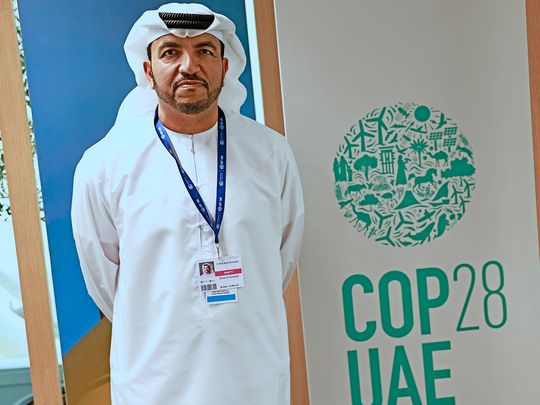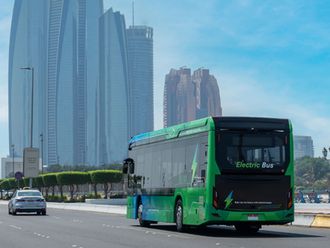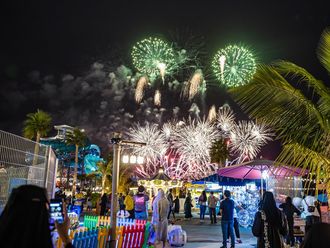
Dubai: We have the right ecosystem and the right mindset to implement practical solutions towards renewable energy, Omar Al Suwaidi, Undersecretary at the Ministry of Industry and Advanced Technology, said yesterday following the launch of the UAE’s Industrial Decarbonisation Roadmap.
The UAE on Tuesday announced the launch of the Industrial Decarbonisation Roadmap with the aim of reducing industrial carbon emissions by 2.9 gigatonnes cumulatively - a 93 per cent reduction - by 2050.
“The UAE was one of the first countries in the region to announce its commitment to Net Zero by 2050, and as part of that plan, the Ministry of Industry and Advanced Technology worked on the industrial sector to put the right targets and the right efforts. Yesterday we announced a roadmap to decarbonise hard-to-abate sectors, including cement, iron, steel and aluminium,” Al Suwaidi said.
The roadmap comprises three phases. The first aims to reduce emissions by five per cent by 2030, while the second targets a 63 per cent reduction by 2040. Through the scaling and decreasing cost of technologies, emissions reduction is expected to reach 93 per cent by 2050.
Read more
- COP28 in UAE: What has space got to do with climate?
- Bee The Change: Expo City Dubai pushes global coalition to save pollinators
- COP28 in Dubai: TikTok launches $1 million initiative to fight climate disinformation and misinformation
- COP28: MoHAP takes proactive role to protect human health from climate change
The roadmap indicates that CCUS (carbon capture, utilisation and storage), clean electricity and efficiency enhancements alone could be responsible for a 70 per cent carbon reduction by 2050, with the remaining 23 per cent made up by other solutions. The action plan set out in the roadmap will cut 90 million tonnes of carbon dioxide annually. Clean electricity alone could contribute to 41 per cent of the targeted reduction by 2050.
“We looked at a number of technology solutions – more than 50 – and came up with a roadmap. As we go along we would like to work on technologies, their scale and their costs. Eventually with these three phases we want to reduce the carbon emissions from these industries by 93 per cent by 2050 in line with our Net Zero commitment,” he said.
“We have been working with other government entities and the private sector to come up with an implementable plan. We know we have clarity for the first few years – till 2030. We have more readily available solutions, but as we go ahead we hope to mature on what we are working on – green hydrogen, carbon capture, storage and utilisation technologies.”
In the energy business, people refer to hydrogen by an array of colours to show how it is created.
Blue hydrogen
Blue hydrogen is when natural gas is split into hydrogen and CO2 either by Steam Methane Reforming (SMR) or Auto Thermal Reforming (ATR), but the CO2 is captured and then stored. As the greenhouse gases are captured, this mitigates the environmental impacts on the planet.
The ‘capturing’ is done through a process called Carbon Capture Usage and Storage (CCUS).
Green hydrogen
Green hydrogen is hydrogen produced by splitting water by electrolysis. This produces only hydrogen and oxygen. The hydrogen can be used and the oxygen is released to the atmosphere with no negative impact.
To achieve the electrolysis power is needed. This process to make green hydrogen is powered by renewable energy sources, such as wind or solar. That makes green hydrogen the cleanest option – hydrogen from renewable energy sources without CO2 as a by-product.
Grey hydrogen
Grey hydrogen has been produced for many years. It is a similar process to blue hydrogen – SMR or ATR are used to split natural gas into Hydrogen and CO2. But the CO2 is not being captured and is released into the atmosphere.
Pink hydrogen
Similar to green hydrogen, pink hydrogen is made via electrolysis, but using nuclear energy as its source of power.
Yellow hydrogen
Another type of hydrogen made by electrolysis is yellow, where electrolysis is achieved solely through solar power (unlike green which could use a combination of renewable energy sources such as wind or solar).
Al Suwaidi acknowledged that not all technologies are available on a large scale and not all companies have the full infrastructure to implement them. “So we are fortunate in the UAE that we tried several solutions – we have a large application of renewable energy, we have carbon capture storage and utilisation. We are starting to work on blue hydrogen and now green hydrogen. So we have the right ecosystem, the right mindset to implement these practical solutions.”
The response from the industries has been positive and as they were part of the development process, they are committed to it, he said. “The challenge now is to have enough renewables. Although we have quite a large capacity in the UAE, there is still a huge demand for the industry.”
What is the role of CCUS in clean energy transitions?
CCUS can be retrofitted to existing power and industrial plants, allowing for their continued operation. It can tackle emissions in hard-to-abate sectors, particularly heavy industries like cement, steel or chemicals. CCUS can remove CO2 from the air to balance emissions that are unavoidable or technically difficult to abate.
- iea.org










